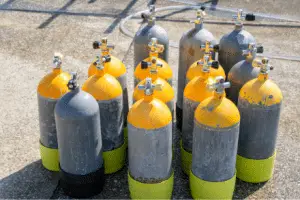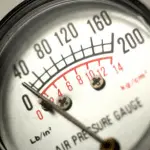One of the most exciting and adventurous hobbies you can pick up is scuba diving. It has many applications, such as in the military, aquarium and ship maintenance, marine biologists, photography, underwater archaeology, and much more. However, it is an essential aspect of underwater recreational activities.
 The initial costs required to go scuba diving depend on multiple factors and involve purchasing a lot of specialized scuba equipment. After those initial costs, there are still more expenses to incur every time you go scuba diving. Besides paying for the entry to dive locations, you will need to refill your scuba tank. So how much can you expect to pay for refilling your air tank?
The initial costs required to go scuba diving depend on multiple factors and involve purchasing a lot of specialized scuba equipment. After those initial costs, there are still more expenses to incur every time you go scuba diving. Besides paying for the entry to dive locations, you will need to refill your scuba tank. So how much can you expect to pay for refilling your air tank?
As you’d expect, it depends. The size and type of air you are using to fill the cylinder can drastically change the amount you pay. Also, different dive shops may set different prices as part of their marketing and promotional strategies. Prices can differ vastly when comparing distant locations, especially worldwide.
Scuba Air Tank Size
 Needless to say, bigger air tanks will require more air and thus are more expensive to fill. Your choice of scuba cylinder depends on the type of scuba diving you intend on doing and your personal preference. Larger cylinders may weigh significantly more or make swimming awkward for you.
Needless to say, bigger air tanks will require more air and thus are more expensive to fill. Your choice of scuba cylinder depends on the type of scuba diving you intend on doing and your personal preference. Larger cylinders may weigh significantly more or make swimming awkward for you.
These are three of the most commonly used scuba cylinder sizes. Of course, sizes are standardized among divers all around the world. Typically their sizes are measured by the capacity of air they carry, measured in cubic feet.
● 100 cu ft, 232 bar
This steel cylinder is the most commonly used among all divers. They come in two sizes (different dimensions), but that should not affect the price of filling them because they carry the same amount of air.
● 80 cu ft, 207 bar (S80)
Made of aluminum, this slightly smaller scuba tank is more prevalent among recreational divers. They have a high buoyancy, making it easier to reach neutral buoyancy.
● 25 cu ft, 232 bar (Emergency cylinder)
These small and compact scuba tanks are usually mounted to the side of the main cylinder as an emergency reserve. They are also available at 300 bar for extra capacity.
Scuba Tank Air Pressure
 There are two types of scuba tanks; one that can withstand more air pressure (300 bar), but the more common type can only withstand 232 bar air pressure. A lower air pressure of 207 bar is also available. The difference between them is that the higher pressure cylinder can carry more air and also weighs more. Scuba tank weights more when they are full. However, keep in mind that not all dive shops are able to fill a 300 bar scuba tank because it is trickier. Also, the cost of refilling them is usually higher (per cubic foot).
There are two types of scuba tanks; one that can withstand more air pressure (300 bar), but the more common type can only withstand 232 bar air pressure. A lower air pressure of 207 bar is also available. The difference between them is that the higher pressure cylinder can carry more air and also weighs more. Scuba tank weights more when they are full. However, keep in mind that not all dive shops are able to fill a 300 bar scuba tank because it is trickier. Also, the cost of refilling them is usually higher (per cubic foot).
What To Fill Your Scuba Tank With
The capacity of your air tanks may change the cost of filling a scuba tank significantly, but the type of breathing gas you are using is an important consideration as well. Scuba tanks can be filled with:
- Compressed air: This is just clean, filtered air that has been compressed to fill a scuba cylinder.
- Nitrox: A mixture of nitrogen and oxygen, which helps reduce the risk of decompression sickness while also prolonging dive time.
- Trimix: A mixture of nitrogen, helium and oxygen, used by advanced divers that go to greater depths. Helium is added to reduce nitrogen narcosis at deeper levels. Note that helium is much more expensive than nitrogen and oxygen.
Filling nitrogen is more labor intensive and requires the cylinder to be ‘cleaned’ first. That’s why dive shops generally charge more (or have a minimum charge) when filling trimix or nitrox.
Dive shops go to great lengths to make sure that their breathing gas is not contaminated, as even the slightest contamination can reach toxic levels when diving to great depths. Examples of contaminants are carbon dioxide, carbon monoxide, or even any of the lubricants used to maintain the compressor.
Prices
As you can see, the cost of filling a scuba tank is not fixed. Taking into account the multiple factors that can affect the price, we’ve put together a small table of approximated prices that we will elaborate on below.
| Gas Type | Capacity | Price |
| Compressed Air | Any Capacity Up to 207 bar | $5 |
| O2 Clean Air* | For cleaning, any capacity | $10 |
| Nitrox | 0-40 cu ft | $3-9 |
| Nitrox | Up to 80 cu ft | $5-20 |
| Nitrox | Up to 100 cu ft | $7-27 |
| Nitrox | Up to 120 cu ft | $10-$32 |
| Helium | 1 cu ft | $3 |
| Oxygen | 1 cu ft | $0.40 |
* Before scuba tanks can be filled with nitrox, they must be cleaned using a special process to give oxygen-clean air. The process is essential for the safety of both the diver and the dive shop employees. This is because pure oxygen can create circumstances where everyday objects become flammable. Special solutions are used to clear any residual flammable substances in the cylinder or its valve. Dive shops usually charge an extra for oxygen cleaning. So, nitrox filling is priced in two parts: oxygen cleaning added to the nitrox gas capacity as needed.
As we’ve mentioned above, the price of filling a tank depends on the type of gas used (or blend of gases). It also depends on the capacity of the scuba tank. Many people forget that filling an empty tank is not like filling a half-full one. That is why, as illustrated in the table above, the price varies according to how full the tank was at the start. This is not an issue when filling compressed air because it is cheap enough to cover all scuba tanks (any capacity, any percentage).
When filling scuba tanks with trimix, the blend chosen depends on the type of diving and depth. So, dive shops sell helium by cubic foot (it is relatively much more expensive) and calculate the cost of filling accordingly. For example, some trimix blends require 35% helium (21% oxygen), which would be priced drastically lower than a 50% helium blend (10% oxygen).
Conclusion
So, to answer our question: How much does it cost to fill a scuba tank?
In my personal experience, depending on the Scuba air Tank Size, Tank Air Pressure, and the different types of filling airs, the cost to fill a scuba tank varies from as little as $5 to fill up to $35. If you add some extra inspections to the scuba tank, like Hydro testing and Oxygen cleaning, the cost may go up to $150.
